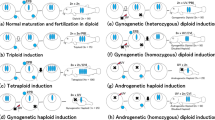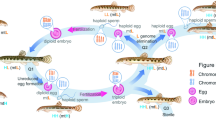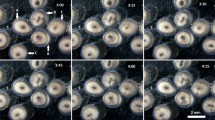Abstract
Crosses between 21 triploid hybrid Cobitis females and 19 C. taenia (2n = 48) males led to viable progeny; whereas no embryonic development was observed in crosses with tetraploid males (4n = 98). The ploidy status of 491 progenies randomly selected with flow cytometry (316) or chromosome analysis (175) revealed an average of 55.2 % triploids and 44.8 % tetraploids, but the ratio of 3n versus 4n fish did change during development. In the first 2 days after hatching, approximately 65.1 % of tetraploid larvae were observed. Their number decreased significantly to 30.8 and 6.2 % on average during 2–5 and 10–15 months of life, respectively. The karyotype of tetraploid progeny (4n = 98) included 3n = 74 chromosomes of the parental female and n = 24 of C. taenia male. The number of tetraploid progeny indicated indirectly that about 66 % of eggs from 3n females were fertilized with C. taenia. The rest of the eggs developed clonally via gynogenesis or hemiclonally via hybridogenesis into triploids of the same karyotype structure as parental females. We have documented for the first time that (at least under experimental conditions) tetraploids are commonly formed, but are less viable than triploids, and a ratio similar to what is found under natural conditions is finally attained. The current explanation concerning the ploidy and karyotype structure of the progeny confirms that the eggs of 3n Cobitis females are not only capable of maintaining all chromosomes but are also capable of incorporating the sperm genome, thus creating the potential to produce tetraploids.




Similar content being viewed by others
References
Arai K (2003) Genetics of the loach, Misgurnus anguillicaudatus: recent progress and perspective. Folia Biol (Krakow) 51S:107–117
Arai K, Fujimoto T (2013) Genomic constitution and atypical reproduction in polyploid and unisexual lineages of the Misgurnus loach, a teleost fish. Cytogenet Genome Res 140:226–240
Boroń A (1999) Banded karyotype of spined loach Cobitis taenia and triploid Cobitis from Poland. Genetica 105:293–300
Boroń A (2003) Karyotypes and cytogenetic diversity of the genus Cobitis (Pisces, Cobitidae) in Poland: a review. Cytogenetic evidence for a hybrid origin of some Cobitis triploids. Folia Biol 51(Suppl):49–54
Boroń A, Ozouf-Costaz C, Coutanceau J-P, Woroniecka K (2006) Gene mapping of 28S and 5S rDNA sites in the spined loach Cobitis taenia (Pisces, Cobitidae) from a diploid population and a diploid-tetraploid population. Genetica 128:71–79
Choleva L, Janko K, De Gelas K, Bohlen J, Šlechtová V, Rábová M, Ráb P (2012) Synthesis of clonality and polyploidy in vertebrate animals by hybridization between two sexual species. Evolution 66–7:2191–2203. doi:10.1111/j.1558-5646.2012.01589.x
Comai L (2005) The advantages and disadvantages of being polyploid. Nat Rev Genet Nat 6:836–846
Crow KD, Stadler PF, Lynch VG, Amemiya C, Wagner GP (2006) The ‘fish-specific’ hox cluster duplication is coincident with the origin of teleost. Mol Biol Evol 23:121–136
Cunha C, Doadrio I, Coelho MM (2008) Speciation towards tetraploidization after intermediate processes of non-sexual reproduction. Philos Trans R Soc B 363:2921–2929
Horvath L, Szabo L, Burke J (1997) Hatchery testing of GnRH analogue containing pellets on ovulation in four cyprinid species. Pol Arch Hydrobiol 44:281–292
Jabłońska O, Juchno D, Nynca A, Swigonska S, Krol M, Leska A, Grabowska A, Kujawa R, Spoz A, Boroń A (2012) Ploidy status of progeny from the crosses between naturally occurred triploid females and diploid males of spined loach (Cobitis, Teleostei). 10th Japan-Korea, Korea-Japan Joint Symposium on Aquaculture, Nagasaki, Japan Book of Abstracts, p 67
Janko K, Flajšhans M, Choleva L, Bohlen J, Šlechtová V, Rábová M, Lajbner Z, Šlechta V, Ivanova P, Dobrovolov I, Culling M, Persat H, Kotusz J, Ráb P (2007a) Diversity of European spined loaches (genus Cobitis L.): an update of the geographic distribution of the Cobitis taenia hybrid complex with a description of new molecular tools for species and hybrid determination. J Fish Biol 71(Suppl. C):387-408
Janko K, Bohlen J, Lamatsch D, Flajšhans M, Epplen JT, Ráb P, Kotlík P, Šlechtová V (2007b) The gynogenetic reproduction of diploid and triploid spined loaches (Cobitis: Teleostei), and their ability to establish successful clonal lineages—on the evolution of polyploidy in asexual vertebrates. Genetica 131:185–194
Janko K, Kotusz J, De Gelas K, Šlechtová V, Opoldusová Z, Drozd P, Choleva L, Popiołek M, Baláž M (2012) Dynamic formation of asexual diploid and polyploid lineages: multilocus analysis of Cobitis reveals the mechanisms maintaining the diversity of clones. PLoS ONE 7(9):e45384. doi:10.1371/journal.pone.0045384
Juchno D, Boroń A (2006a) Comparative histology of the testes of the spined loach Cobitis taenia L. and natural allotetraploids of Cobitis (Pisces, Cobitidae). Hydrobiologia 573:45–53
Juchno D, Boroń A (2006b) Age, reproduction and fecundity of spined loach Cobitis taenia L. (Pisces, Cobitidae) from Lake Klawój (Poland). Reprod Biol 6(2):133–148
Juchno D, Boroń A, Gołaszewski J (2007) Comparative morphology and histology of the ovaries of the spined loach Cobitis taenia L. and natural allopolyploids of Cobitis (Cobitidae). J Fish Biol 70:1392–1411
Kim IS, Lee EH (2000) Hybridization experiment of diploid-triploid cobitid fishes, Cobitis sinensis-longicorpus complex (Pisces: Cobitidae). Folia Zool 49(S1):17–22
Kottelat M (2012) Conspectus cobitidum*: an inventroy of the loaches of the word (Teleostei: Cypriniformes: Cobitoidei). Raffles Bull Zool 26(Suppl):1–199
Lebedeva EB, Vasil’ev VP, Ryskov AP (2005) The gynogenetic form of fish from the genus Cobitis (Cobitidae) in a region of its geographic range is monoclonal: DNA fingerprinting data. Dokl Biol Sci 401:136–138
Levan A, Fredga K, Sandberg AA (1964) Nomenclature for centromeric position on chromosomes. Hereditas 52:201–220
Li YJ, Zhang MZ, Qian C, Gao M, Arai K (2012) Fertility and ploidy of gametes of diploid, triploid and tetraploid loaches, Misgurnus anguillicaudatus, in China. J Appl Ichthyol 28:900–905
Mable BK, Alexandrou MA, Taylor MI (2011) Genome duplication in amphibians and fish: an extended synthesis. J Zool 284:151–182
Maciak S, Janko K, Kotusz J, Choleva L, Boroń A, Juchno D, Kujawa R, Kozłowski J, Konarzewski M (2011) Standard metabolic rate (SMR) is inversely related to erythrocyte and genome size in allopolyploid fish of the Cobitis taenia hybrid complex. Funct Ecol 25(5):1072–1078
Saat TV (1991) Reproduction of the diploid and polyploid spinous loaches (Cobitis, Teleostei). Oocyte maturation and fertilization in the triploid form. Ontogenez 22:533–541 (in Russian)
Saitoh K, Kim IS, Lee EH (2004) Mitochondrial gene introgression between spined loaches via hybridogenesis. Zool Sci 21:795–798
Saitoh K, Chen WJ, Mayden RL (2010) Extensive hybridization and tetrapolyploidy in spined loach fish. Mol Phylogenet Evolut 56:1001–1010
Schultz RJ (1969) Hybridisation, unisexuality and polyploidy in the teleost Poeciliopsis (Poeciliidae) and other vertebrates. Am Nat 103:605–619
Vasil’ev P, Vasil’eva KD, Osinov AG (1983) The first evidence in favor of the main hypothesis of reticular speciation in vertebrates. Dokl Akad Nauk SSSR 271(4):1009–1012
Vasil’ev P, Vasil’eva KD, Osinov AG (1989) Evolution of diploid-triploid-tetraploid complex in fishes of the genus Cobitis (Pisces, Cobitidae). In: Dawley RM, Bogart JP,(eds) Evolution and ecology of unisexual vertebrates. New York State Museum. pp 153–169
Vasil’ev VP, Lebedeva EB, Vasil’eva ED, Ryskov AP (2007) Monoclonal and de novo arising tetraploid forms of the genus Cobitis (Cobitidae) from different clonal-bisexual complexes. Doklady Biol Sci 416:360–363
Vrijenhoek RC (1989) Genetic and evolutionary constraints on the origin and establishment of unisexual vertebrates. In: Dawley RM, Bogart JP (eds) Evolution and ecology of unisexual vertebrates. New York State Museum, Albany, pp 24–31
Zhang Q, Arai K, Yamashita M (1998) Cytogenetic mechanisms for triploid and haploid egg formation in the triploid loach Misgurnus anguillicaudatus. J Exp Zool 281:608–619
Acknowledgments
We would like to express our sincere thanks to dr Slawomir Boroń for fish collecting. This work was supported by The National Science Centre, Poland; Grant number: N N303 068834 and The University of Warmia and Mazury in Olsztyn; Grant number: 0208.806.
Author information
Authors and Affiliations
Corresponding author
Rights and permissions
About this article
Cite this article
Juchno, D., Jabłońska, O., Boroń, A. et al. Ploidy-dependent survival of progeny arising from crosses between natural allotriploid Cobitis females and diploid C. taenia males (Pisces, Cobitidae). Genetica 142, 351–359 (2014). https://doi.org/10.1007/s10709-014-9779-0
Received:
Accepted:
Published:
Issue Date:
DOI: https://doi.org/10.1007/s10709-014-9779-0




